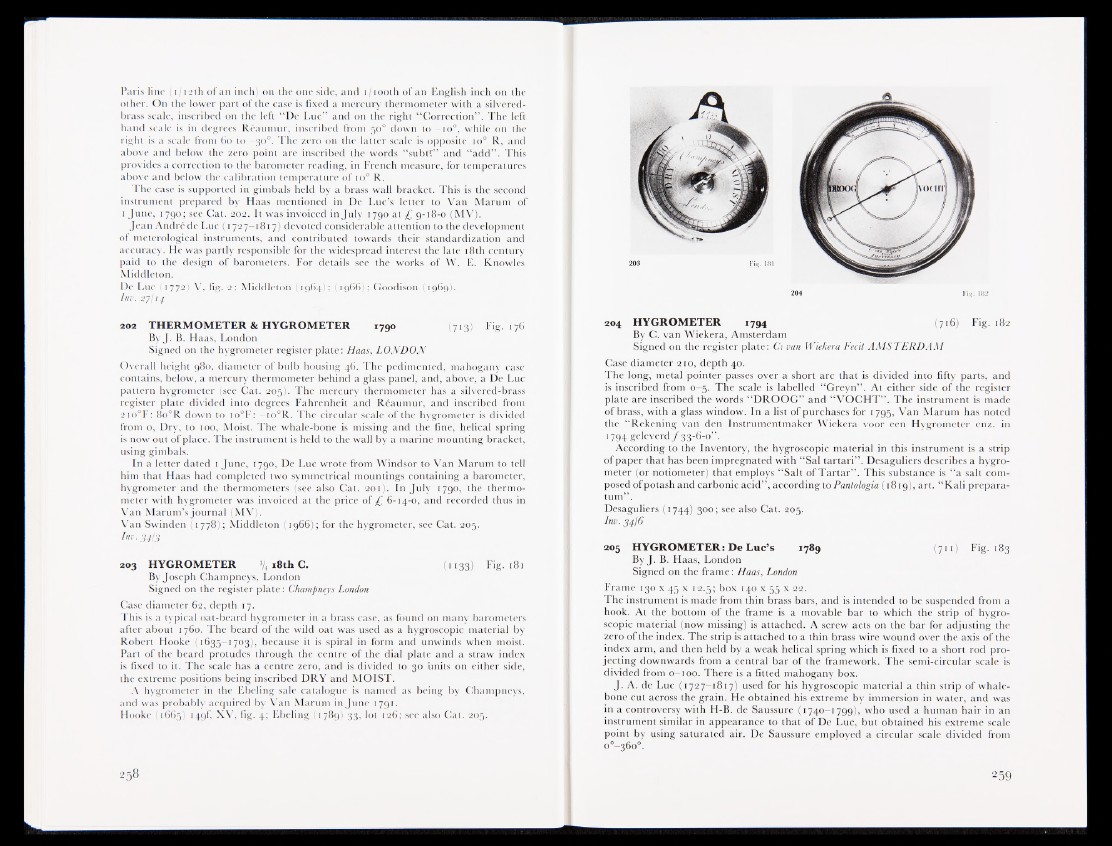
Paris line (i/iath of an inch) on the one side, and i/iooth of an English inch on the
other. On the lower part of the case is fixed a mercury thermometer with a silvered-
brass scale, inscribed on the left “De Luc” and on the right “ Correction” . The left
hand scale is in degrees Reaumur, inscribed from 50° down to —io°, while on the
right is a scale from 60 to —30'*; The zero on the latter scale is opposite io° R, and
above and below the zero point are inscribed the words “ subtf” and “ add” . This
provides a correction to the barometer reading, in French measure, for temperatures
above and below the calibration temperature of io° R.
The case is supported in gimbals held by a brass wall bracket. This is the second
instrument prepared by Haas mentioned in De Luc’s letter to Van Marum of
i June, i 790; see Cat. 202. It was invoiced in July 1790 at £ 9-18-0 (MV).
Jean Andre de Luc (1727—1817) devoted considerable attention to the development
of meterological instruments, and contributed towards their standardization and
accuracy. He was partly responsible for the widespread interest the late 18th century
paid to the design of barometers. For details see the works of W. E. Knowles
Middleton.
De Luc (1772) V, fig. 2; Middleton (1964); ;|i966); Goodison (1969).
Inv. 27/14
202 THERMOMETER & HYGROMETER 1790 (7i p Fig 176
By J. B. Haas, London
Signed on the hygrometer register plate: Haas, LONDON
Overall height 980, diameter of bulb housing 46. The pedimented, mahogany case
contains, below, a mercury thermometer behind a glass panel, and, above, a De Luc
pattern hygrometer (see Cat. 205). The mercury thermometer has a silvered-brass
register plate divided into degrees Fahrenheit and Réaumur, and inscribed from
2io°F: 8o°R down to io°F: —io°R. The circular scale of the hygrometer is divided
from o, Dry, to too, Moist. The whale-bone is missing and the fine, helical spring
is now out of place. The instrument is held to the wall by a marine mounting bracket,
using gimbals.
In a letter dated 1 June, 1790, De Luc wrote from Windsor to Van Marum to tell
him that Haas had completed two symmetrical mountings containing a barometer,
hygrometer and the thermometers (see also Cat. 201). In July 1790, the thermometer
with hygrometer was invoiced at the price of £ 6-14-0, and recorded thus in
Van Marum’sjournal (MV).
Van Swinden (1778); Middleton (1966) ; for the hygrometer, see Cat. 205.
Inv. 34/3
203 HYGROMETER 3/4 18th C. (1133) Fig. 181
By Joseph Champneys, London
Signed on the register plate: Champneys London
Case diameter 62, depth 17.
This is a typical oat-beard hygrometer in a brass case, as found on many barometers
after about 1760. The beard of the wild oat was used as a hygroscopic material by
Robert Hooke (1635—1703), because it is spiral in form and unwinds when moist.
Part of the beard protudes through the centre of the dial plate and a straw index
is fixed to it. The scale has a centre zero, and is divided to 30 units on either side,
the extreme positions being inscribed DRY and MOIST.
A hygrometer in the Ebeling sale catalogue is named as being by Champneys,
and was probably acquired by Van Marum in June 1791.
Hooke (1665) 1496 XV, fig. 4; Ebeling (1789) 33, lot 126; see also Cat. 205.
204 HYGROMETER 1794 (716) Fig. 182
By C. van Wiekera, Amsterdam
Signed on the register plate: Ci van Wiekera Fecit AMSTERDAM
Case diameter 210, depth 40.
The long, metal pointer passes over a short arc that is divided into fifty parts, and
is inscribed from 0—5. The scale is labelled “Greyn” . At either side of the register
plate are inscribed the words “DROOG” and “VOCHT” . The instrument is made
of brass, with a glass window. In a list of purchases for 1795, Van Marum has noted
the “ Rekening van den Instrumentmaker Wiekera voor een Hygrometer enz. in
1794 geleverd f 33-6-0” .
According to the Inventory, the hygroscopic material in this instrument is a strip
of paper that has been impregnated with “ Sal tartari” . Desaguliers describes a hygrometer
|ir notiometer) that employs “ Salt of Tartar” . This substance is “ a salt composed
of potash and carbonic acid” , according to Pantologia (1819), art. “Kali prepara-
tum” .
Desaguliers (1744) 300; see also Cat. 205.
Inv. 34/0
205 HYGROMETER: De Luc’s *789 (711) Fig- 183
By J. B. Haas, London
Signed on the frame: Haas, London
Frame 130 x 45 x 12.5; box 140 x 55 x 22.
The instrument is made from thin brass bars, and is intended to be suspended from a
hook. At the bottom of the frame is a movable bar to which the strip of hygroscopic
material (now missing) is attached. A screw acts on the bar for adjusting the
zero of the index. The strip is attached to a thin brass wire wound over the axis of the
index arm, and then held by a weak helical spring which is fixed to a short rod projecting
downwards from a central bar of the framework. The semi-circular scale is
divided from o—100. There is a fitted mahogany box.
J. A. de 1.110 (1727 1817) used for his hygroscopic material a thin strip of whalebone
cut across the grain. He obtained his extreme by immersion in water, and was
in a controversy with H-B. de Saussure (1740-1799), who used a human hair in an
instrument similar in appearance; to that of De Luc, but obtained his extreme scale
point by using saturated air. De Saussure employed a circular scale divided from
o° 360°.